Hold down the T key for 3 seconds to activate the audio accessibility mode, at which point you can click the K key to pause and resume audio. Useful for the Check Your Understanding and See Answers.
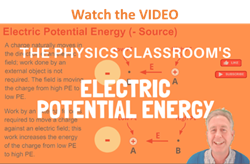 Perhaps one of the most useful yet taken-for-granted accomplishments of the recent centuries is the development of electric circuits. The flow of charge through wires allows us to cook our food, light our homes, air-condition our work and living space, entertain us with movies and music and even allows us to drive to work or school safely. In this unit of The Physics Classroom, we will explore the reasons for why charge flows through wires of electric circuits and the variables that affect the rate at which it flows. The means by which moving charge delivers electrical energy to appliances in order to operate them will be discussed in detail.
Perhaps one of the most useful yet taken-for-granted accomplishments of the recent centuries is the development of electric circuits. The flow of charge through wires allows us to cook our food, light our homes, air-condition our work and living space, entertain us with movies and music and even allows us to drive to work or school safely. In this unit of The Physics Classroom, we will explore the reasons for why charge flows through wires of electric circuits and the variables that affect the rate at which it flows. The means by which moving charge delivers electrical energy to appliances in order to operate them will be discussed in detail.
One of the fundamental principles that must be understood in order to grasp electric circuits pertains to the concept of how an electric field can influence charge within a circuit as it moves 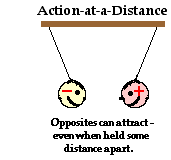 from one location to another. The concept of electric field was first introduced in the unit on Static Electricity. In that unit, electric force was described as a non-contact force. A charged balloon can have an attractive effect upon an oppositely charged balloon even when they are not in contact. The electric force acts over the distance separating the two objects. Electric force is an action-at-a-distance force.
from one location to another. The concept of electric field was first introduced in the unit on Static Electricity. In that unit, electric force was described as a non-contact force. A charged balloon can have an attractive effect upon an oppositely charged balloon even when they are not in contact. The electric force acts over the distance separating the two objects. Electric force is an action-at-a-distance force.
Action-at-a-distance forces are sometimes referred to as field forces. The concept of a field force is utilized by scientists to explain this rather unusual force phenomenon that occurs in the absence of physical contact. The space surrounding a charged object is affected by the presence of the charge; an electric field is established in that space. A charged object creates an electric field - an alteration of the space or field in the region that surrounds it. Other charges in that field would feel the unusual alteration of the space. Whether a charged object enters that space or not, the electric field exists. Space is altered by the presence of a charged object; other objects in that space experience the strange and mysterious qualities of the space. As another charged object enters the space and moves deeper and deeper into the field, the effect of the field becomes more and more noticeable.
Electric field is a vector quantity whose direction is defined as the direction that a positive test charge would be pushed when placed in the field. Thus, the electric field direction about a positive source charge is always directed away from the positive source. And the electric field direction about a negative source charge is always directed toward the negative source.
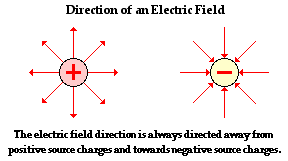
Electric Field, Work, and Potential Energy
Electric fields are similar to gravitational fields - both involve action-at-a-distance forces. In the case of gravitational fields, the source of the field is a massive object and the action-at-a-distance forces are exerted upon other masses. When the concept of the force of gravity and energy was discussed in Unit 5 of the Physics Classroom, it was mentioned that the force of gravity is an internal or conservative force. When gravity does work upon an object to move it from a high location to a lower location, the object's total amount of mechanical energy is conserved. However, during the course of the falling motion, there was a loss of potential energy (and a gain of kinetic energy). When gravity does work upon an object to move it in the direction of the gravitational field, then the object loses potential energy. The potential energy originally stored within the object as a result of its vertical position is lost as the object moves under the influence of the gravitational field. On the other hand, energy would be required to move a massive object against its gravitational field. A stationary object would not naturally move against the field and gain potential energy. Energy in the form of work would have to be imparted to the object by an external force in order for it to gain this height and the corresponding potential energy.
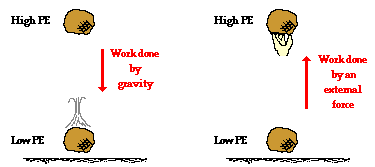
The important point to be made by this gravitational analogy is that work must be done by an external force to move an object against nature - from low potential energy to high potential energy. On the other hand, objects naturally move from high potential energy to low potential energy under the influence of the field force. It is simply natural for objects to move from high energy to low energy; but work is required to move an object from low energy to high energy.
In a similar manner, to move a charge in an electric field against its natural direction of motion would require work. The exertion of work by an external force would in turn add potential energy to the object. The natural direction of motion of an object is from high energy to low energy; but work must be done to move the object against nature. On the other hand, work would not be required to move an object from a high potential energy location to a low potential energy location. When this principle is logically extended to the movement of charge within an electric field, the relationship between work, energy and the direction that a charge moves becomes more obvious.
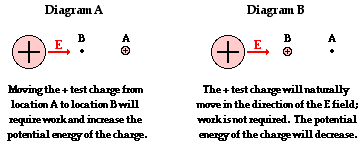
Consider the diagram above in which a positive source charge is creating an electric field and a positive test charge being moved against and with the field. In Diagram A, the positive test charge is being moved against the field from location A to location B. Moving the charge in this direction would be like going against nature. Thus, work would be required to move the object from location A to location B and the positive test charge would be gaining potential energy in the process. This would be analogous to moving a mass in the uphill direction; work would be required to cause such an increase in gravitational potential energy. In Diagram B, the positive test charge is being moved with the field from location B to location A. This motion would be natural and not require work from an external force. The positive test charge would be losing energy in moving from location B to location A. This would be analogous to a mass falling downward; it would occur naturally and be accompanied by a loss of gravitational potential energy. One can conclude from this discussion that the high energy location for a positive test charge is a location nearest the positive source charge; and the low energy location is furthest away.
The above discussion pertained to moving a positive test charge within the electric field created by a positive source charge. Now we will consider the motion of the same positive test charge within the electric field created by a negative source charge. The same principle regarding work and potential energy will be used to identify the locations of high and low energy.
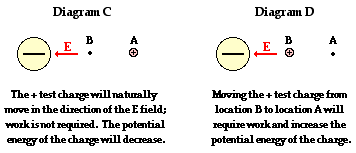
In Diagram C, the positive test charge is moving from location A to location B in the direction of the electric field. This movement would be natural - like a mass falling towards Earth. Work would not be required to cause such a motion and it would be accompanied by a loss of potential energy. In Diagram D, the positive test charge is moving from location B to location A against the electric field. Work would be required to cause this motion; it would be analogous to raising a mass within Earth's gravitational field. Since energy is imparted to the test charge in the form of work, the positive test charge would be gaining potential energy as the result of the motion. One can conclude from this discussion that the low energy location for a positive test charge is a location nearest a negative source charge and the high energy location is a location furthest away from a negative source charge.
As we begin to discuss circuits, we will apply these principles regarding work and potential energy to the movement of charge about a circuit. Just as we reasoned here, moving a positive test charge against the electric field will require work and result in a gain in potential energy. On the other hand, a positive test charge will naturally move in the direction of the field without the need for work being done on it; this movement will result in the loss of potential energy. Before making this application to electric circuits, we need to first explore the meaning of the concept electric potential.